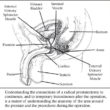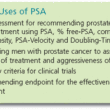What the U.S. Preventive Services Task Force Missed in Its Prostate Cancer Screening Recommendation
William J. Catalona, MD; Anthony V. D’Amico, MD; William F. Fitzgibbons, MD; Omofolasade Kosoko-Lasaki, MD; Stephen W. Leslie, MD; Henry T. Lynch, MD; Judd W. Moul, MD; Marc S. Rendell, MD; and Patrick C. Walsh, MD

The U.S. Preventive Services Task Force (USPSTF), a panel that does not include urologists or cancer specialists, has just recommended against prostate-specific antigen (PSA)-based screening for prostate cancer, stating that “screening may benefit a small number of men but will result in harm to many others.”
Recognizing that prostate cancer remains the second-leading cause of cancer deaths in men, we, an ad hoc group that includes nationally recognized experts in the surgical and radiological treatment of prostate cancer, oncologists, preventive medicine specialists, and primary care physicians, believe that the USPSTF has underestimated the benefits and overestimated the harms of prostate cancer screening. Therefore, we disagree with the USPSTF’s recommendation.
The USPTSF bases its recommendation, in large part, on the 2 largest published randomized clinical trials. The U.S. PLCO (Prostate, Lung, Colorectal, and Ovarian) Cancer Screening Trial randomly assigned 76,685 men ages 55 to 74 years to receive either annual screening for 6 years or “usual care”. By 2009, 57% of the men had been followed for at least 13 years. The cumulative incidence rate for prostate cancer was slightly higher in the screened group, and prostate cancer mortality did not differ significantly between groups.
The ERSPC (European Randomized Study of Screening for Prostate Cancer) randomly assigned 162,243 men aged 55 to 69 years to either PSA screening once every 4 years or to an unscreened control group. After a median of 11 years of follow-up, the cumulative incidence of prostate cancer was 8.2% in the screened group and 4.8% in the control group. Prostate cancer death was reduced by 21% in the screened compared with the control group and 29% after adjustment for noncompliance.
The Task Force concluded that this decrease in prostate cancer–specific mortality amounted to few lives saved and did not outweigh the harms of screening and diagnosis (false-positive results and associated anxiety and biopsy complications) and the harms related to the treatment of screendetected cancer.
The Task Force’s evidence review did acknowledge strong evidence that treatment of localized prostate cancer reduced mortality compared with observation alone, citing a Scandinavian randomized, controlled trial with 15 years of follow-up showing that radical prostatectomy resulted in a sustained 38% decrease in prostate cancer–specific mortality and 25% reduction in all-cause mortality. It also acknowledged other trials of surgery and radiation therapy showing an approximate 35% decrease in mortality. However, the Task Force’s view was that perioperative events, urinary incontinence, and erectile dysfunction as complications of prostatectomy and bowel problems associated with radiation therapy must be considered, in addition to the mortality benefits of treatment.

In formulating its recommendation, we believe that the USPSTF either overlooked or misinterpreted the effect of significant methodological flaws in the 2 major clinical trials of screening.
The most important flaws of the PLCO are the greater than 50% “contamination” rate by nonprotocol PSA measurements in the control group, prescreening of 40% of study participants before enrollment in the trial, and the fact that two thirds of patients with abnormal screening tests did not have prompt biopsy.
These issues, in our opinion, impair the claim that the PLCO is a true screening trial. In the ERSPC, compared with the PLCO, participants were younger, the PSA cutoff was lower, there was only approximately 15% “contamination,” and prompt biopsy was done far more frequently after positive PSA values.
A secondary analysis of data from the Rotterdam site of the ERSPC that corrected for failure of participants to have protocol- prescribed screening procedures as well as contamination showed that PSA screening reduced the risk for dying of prostate cancer by as much as 31%.
A further limitation of both trials was having only a median follow-up of roughly 10 years, which we believe is of inadequate duration for an often slowly progressive cancer such as prostate cancer. The Task Force gave little weight to the longer Goteborg Randomized Population- Based Prostate-Cancer Screening Trial, which had better protocol compliance and in which the interim 14-year median follow-up results showed a greater (44%) reduction in death from prostate cancer for the screened group.
In addition to misinterpreting the potential effect of the limitations of the 2 largest screening trails, we believe that the Task Force had other flaws in its reasoning.
First, it overlooked the fact that diagnostic procedures and related complications occur in unscreened populations as well, and at a later stage of cancer discovery. In the ERSPC trial, higher-grade cancer (Gleason score 7) was more common in the control group (45.2%) versus the screened group (27.8%), with a 40% greater incidence of locally advanced and metastatic cancer.
Undeniably, victims of advanced prostate cancer endure more invasive and harmful procedures than those with organ-confined disease. Second, the Task Force analysis focused on mortality and ignored the substantial illness associated with living with advanced cancer. Disseminated prostate cancer is characterized by painful bone metastases, pathologic fractures, and urinary tract obstruction.
A comprehensive comparative analysis of benefits and harms in screened and control populations should consider the complications of advanced cancer, which could be more common in unscreened groups.
Third, we believe that the Task Force recommendation lacks adequate consideration of high-risk populations, including men with a family history of prostate cancer and men of African descent, who have a 1.4-times higher risk for being diagnosed with and 2- to 3-times higher risk for dying of prostate cancer compared with European American men.
Fourth, the USPSTF did not adequately emphasize epidemiologic data that shows that since the widespread use of PSA testing began in the early 1990s, there has been a 40% decrease in prostate cancer deaths and a 75% decrease in presentation with advanced disease at initial diagnosis, which is attributed, in large part, to PSA screening.
A recent National Institutes of Health Consensus Development Conference concluded that “prior to the adoption of PSA screening, the majority of prostate cancer was detected because of symptoms of advanced cancer or a nodule found on digital rectal examination. The symptomatic tumors were usually high-grade, advanced, and often lethal”.
Finally, the Task Force recommendation opposes PSA testing regardless of age. The expected life span for a man aged 75 years is approximately 10 years but reaches 30 years for men at age 45 to 50 years.
It is plausible that many men aged 75 years or older will die of other causes before developing metastatic prostate cancer, but the current recommendation, arguably to avoid adverse effects of screening, could result in delayed diagnosis of curable cancer in young men who may then present with advanced disease, illness, and ultimately die from prostate cancer.
The Task Force recommendation relies solely on mortality data from the PLCO and the ERSPC and early data from the Prostate Cancer Intervention Versus Observation Trial.
We believe that studies with only a 10-year median follow-up are insufficient to dictate how a man with prostate cancer aged 50 to 60 years should be treated.
The recommendations of the USPSTF carry considerable weight with Medicare and other third-party insurers and could affect the health and lives of men at high risk for life-threatening disease. We believe that elimination of reimbursement for PSA testing would take us back to an era when prostate cancer was often discovered at advanced and incurable stages.
At this point, we suggest that physicians review the evidence, follow the continuing dialogue closely, and individualize prostate cancer screening decisions on the basis of informed patient preferences.
reprinted with permission from Annals of Internal Medicine, May 17, 2012











